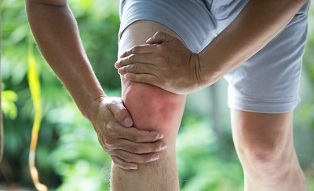
Arthrosis of the knee, or gonarthrosis, mainly affects women, usually after the age of forty. At an earlier age, such pathologies can develop as a result of injury or professional sports. Very severe disease is observed in people who are overweight or suffer from varicose veins in the lower legs.
The onset of the disease is characterized by the appearance of mild pain in the knee during movement, especially when walking on stairs. Also, pain can occur if a person stands for a long time or stands after a long stay in a sitting position. At rest, the pain usually subsides. Sharp and intense pain in arthrosis of the knee joint does not occur spontaneously, usually it is preceded by long-term discomfort while walking, doing physical activity. This is a growing pain that is one of the main signs of gonarthrosis.
Stages of this disease
First stage
In the early stages of the development of gonarthrosis, the bones in the knee do not change shape, only swelling of the joints can occur, usually associated with fluid accumulation in the knee. If the amount exceeds the allowable level, edema develops, which affects the back of the foot. In this case, you can relieve the swelling with the help of anti-inflammatory drugs.
Second stage
The next stage of knee arthrosis is characterized by a significant increase in pain intensity. The pain makes itself felt even after a slight load, cramps appear in the knee joint, which increases if the disease persists. The patient bends the leg hard, there is severe pain, so it is impossible to bend it at the knee. Also in the second stage of the disease, the joints begin to change shape, which becomes very noticeable on palpation - the expansion and swelling of the articular bone is felt. Synovitis manifests itself more strongly at this stage - the appearance of swelling due to fluid accumulation.
Third level
The third stage of the disease is characterized by the appearance of intense pain that occurs even at rest. The patient seeks a suitable position for a long time, during which the pain will weaken. With disturbed blood circulation, pain can bother a person even during sleep, causing pain in the joints. Joint mobility is minimized, the person is often unable to keep the foot in a straight position and is forced to bend it while walking. With significant bone deformation, gait becomes shaky, deformation of the lower extremities becomes noticeable.
How to recognize knee joint arthrosis?

Patients were initially referred for a blood test, followed by x-rays, magnetic resonance imaging or computed tomography.
In some cases, ultrasound or arthroscopy (examination of a joint with a special tool through a small incision) may be prescribed.
During X-ray examination, the stage of disease progression is determined, the picture shows changes in the joints and bones, as well as the distance between the bones. In the early stages of the disease, changes in cartilage tissue are not visible on x-rays.
Ultrasound examination, as well as computed tomography, makes it possible to reveal abnormalities in soft articular tissue and to determine the amount of fluid accumulated during the development of synovitis.
How to treat knee arthrosis?
Arthrosis of the knee is treated by a specialist such as a rheumatologist or orthopedist. In the early stages, the disease in most cases can be cured without surgery, but the treatment must be comprehensive and quality. In the second and third stages, it is impossible to restore the joint to its previous form without surgery, it is only possible to improve the condition of periarticular tissue.
Nonsteroidal anti-inflammatory drugs are widely used to reduce inflammation and pain in arthrosis of the knee joint. After reducing the pain syndrome, patients can be given massage treatment, therapeutic training, physiotherapy procedures.
For the treatment of gonarthrosis, drugs are also used which are part of the group of chondroprotectors and provide recovery of cartilage tissue. Such preparations can also help maintain cartilage elasticity, tissue saturation with moisture. In the first and second stages, chondroprotectors have a gradual effect, the treatment is quite long and can even last a year or one and a half years. Taking glucosamine and chondroitin sulfate together has a greater effect. In the third stage, the drugs can no longer have a positive effect.
Good effect in the treatment of arthrosis has drugs that work to expand blood vessels. They can improve blood circulation in the joints and relieve cramps in the small ducts, which helps restore the affected joints. It is recommended to combine the intake of such drugs with the use of chondroprotectors. To relieve painful muscle spasms, muscle relaxants can be prescribed to patients. Such drugs are used only in combination with chondroprotectors and joint traction. Dimexide compresses also have a positive effect in the treatment of arthrosis, which can reduce inflammation and relieve pain, especially when fluids accumulate. To prepare such a compress, you should mix one tablespoon of boiled water with one tablespoon of Dimexide. Then moisten the medical bandage in the resulting solution, then attach the affected joint and cover with a plastic bag and diaper on it. The duration of the procedure is from twenty to sixty minutes, once a day, no more, for two to three weeks.
All drugs are used if there are no contraindications, strictly according to the doctor's prescription. Arthrosis of the knee joint requires medication and physiotherapy training and therapy.

























